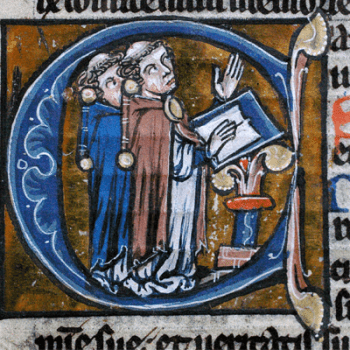A thin blue line runs through the nave of Durham Cathedral in England. Made from marble and marked with a center cross, it stretches twenty-five feet across the westernmost part of the nave. Medieval legend proclaims the line as a physical barrier protecting the sacred space of the clergy from the polluting presence of women. Unlike men, medieval women were forbidden to step over the line and enter the regular space of the church.
At first glance, this thin blue line seems to scream medieval misogyny.
But, stay with me, because there is more to the story…..
So let’s go back to Durham Cathedral. Harrowing stories from the 12th century life of St. Cuthbert (the patron saint of Durham Cathedral) tell of the consequences for women who attempted to transgress the thin blue line. One woman was struck with madness for just trying to take a shortcut. She was upset about the poor quality of the traveling road, as her feet kept sinking into deep puddles. So she decided to cut through the well-kept churchyard of Durham cathedral.
Her punishment was severe. As Simeon of Durham’s twelfth-century history of the church reads: “she was seized with some kind of indefinite horror, and cried out that she was gradually losing her senses.” After falling down in a fit, she was carried home where she died. Another female transgressor was “inflamed woman-like” (as the text reads) to see the beautiful decorations within the church. The text continues: “Unable to bridle her impetuous desires, for the power of her husband had elevated her above her neighbours, she walked through the cemetery of the church.” Her punishment, perhaps because she was motivated by pride, was even more horrific. She went mad, bit out her own tongue, and then committed suicide by slitting her own throat. The account concludes with this statement: “Many other instances might easily be added to these, showing how the audacity of women was punished from heaven; but let these suffice…” (See Emilie Amt’s Women’s Lives in Medieval Europe if you would like a translated version of this source.)
While certainly extreme, these tales from Durham Cathedral are mostly not surprising. They fit with our understanding of how the medieval church, with its concern for sacerdotal purity, excluded the polluting presence of the female body from sacred space. A story about an exploding womb from the Life of St. Augustine graphically demonstrates how women’s bodies were perceived to physically contaminate sacred space. The narrative describes a woman who tried to enter a church nave in France that enforced gender restrictions similar to those in Durham. When she approached the boundary line, the text explicitly states how her “entrails suddenly burst out; the secret parts of her womb flowed upon the earth, and she fell down miserably and died.”
These are difficult stories. They not only clearly prohibit women from the sacred space off the nave, but they underscore the divinely-proclaimed consequences for female transgressors—painful and poignant death.
As I have already suggested, however, there is more to these stories than simple misogyny. Cuthbert, a 7th century saint, did not become a misogynist until four hundred years after his death. The stories blaming him for forbidding women from entering Durham Cathedral have a very particular source. They stem from the 1083 (post-Norman Conquest) replacement of married clergy at Durham cathedral with Benedictine monks. This was a difficult change to enforce, as you might well imagine. To help smooth the transition, Jane Tibbets Schulenburg in her 2005 article “Gender, Celibacy, and Proscriptions of Sacred Space” writes, “the famous seventh-century patron St. Cuthbert was conveniently provided with a posthumous abhorrence of females. Thus the reform writings of Symeon of Durham served to reshape the patron saint of Durham according to the blatant prejudices of the period.” Cuthbert became a misogynist to further the ecclesiastical campaign for clerical celibacy.
Wait–did you hear that? Cuthbert became a posthumous misogynist to further the ecclesiastical campaign for clerical celibacy. Cuthbert himself never really had a problem with women (in fact, evidence from his life shows that he worked well and closely with women).
In other words, the exclusion of women from the nave of Durham Cathedral stemmed from an attempt to enforce clerical celibacy. Indeed, the woman who died because of her “impetuous desires” to see the beauty of Durham Cathedral was married to a man who, after being widowed, wore the “dress of a monk”. The death of a woman through the “curse” of Cuthbert helped enforce clerical celibacy for a new member of the monastic community.
So what was really going on in Durham Cathedral? The prohibitions made against women had little to do with women. The prohibitions had to do with men in the church trying to enforce an unpopular law. This reminds me of a statement often made by Ben Witherington III: “the problem in the church is not strong women, but rather weak men who feel threatened by strong women…..”
Let’s just think about that for a while.












